Medical Elastomers: Polymer Materials Enhancing Patient Care and Medical Outcomes
 |
| Medical Elastomers |
History and Development of Medical
Elastomers
The origins of modern medical elastomers dates back to the late 19th century
when vulcanized rubber was first discovered and began being utilized for
various medical devices and applications. Some of the earliest uses included
rubber gloves, catheters, and surgical tubing due to rubber's desirable
properties including flexibility, elasticity, and ability to create a seal.
However, it wasn't until the 1930s-40s that the development of synthetic
polymers like silicone and polyurethane accelerated their use in healthcare.
During World War II, silicone's heat resistance made it well-suited for
applications involving burns treatment and led to advances in skin grafting
techniques.
In the 1950s, major developments included the first cardiac pacemakers
constructed partially from silicone elastomers and the rise of polyvinyl
chloride or PVC in medical tubing and blood bags due to its flexibility,
resistance to chemicals/bacteria, and relatively low cost. The 1960s saw
expanded use of silicone in implants like penile and breast implants as well as
the introduction of long-term indwelling catheters made possible by the
slippery hydrophilic coating on latex and silicone. Throughout the 1970s-90s,
advancements continued at a rapid pace with elastomer innovations enabling
minimally invasive surgery, better wound dressings, cardiovascular implants,
and more.
Key Properties and Types of Medical
Elastomers
Thermoplastic elastomers like silicone, PVC, latex, and C-Flex remain popular
choices today due to beneficial properties including biocompatibility,
flexibility, elasticity, abrasion/chemical resistance, and sterilizability.
Each type also has distinguishing qualities suiting different medical
applications:
- Silicone is highly flexible and heat-resistant, making it ideal for implants,
prosthetics, IV tubes, and other devices requiring durability. It provides a
low friction surface and does not degrade over time like other materials.
- Latex, though more allergenic than others, offers elasticity, tactile
sensitivity for exam gloves, and lower costs. It requires powder to prevent
sticking.
- Polyurethane combines tear resistance with elasticity well-suited for wound
dressings, catheters, and ostomy bags requiring a tight yet flexible seal.
- Thermoplastic elastomers like C-Flex are similar to PVC but offer improved
flexibility, clarity for part visualization, and shape memory
post-sterilization.
These elastomers can be compounded with other additives to enhance their
safety, performance qualities like radiopacity, or tailor properties to very
specific applications.Their biocompatibility means they interact harmlessly
with the human body, minimizing adverse tissue reactions.
Elastomer Applications Transforming
Patient Care
From minimally invasive surgery to advanced wound care to prosthetics and more,
Medical
Elastomers impact patient outcomes across many disciplines. Some key
ways elastomers are enhancing care include:
- Silicone catheterization enables managing urinary issues long-term without
requiring new invasive insertions frequently. This improves quality of life.
- Silicone-coated wound dressings form moisture-retaining barriers protecting
injuries from contamination while allowing for visibility and drainage. This
speeds healing of complex chronic wounds.
- Silicone gel-filled breast implants offer a soft, natural feel restoring
confidence while PVC/C-Flex ostomy bags comfortably collect waste despite
active lifestyles. Both improve psychological well-being.
- Silicone-urethane balloons on cardiac stents properly expand to reopen
clogged arteries during angioplasty. This relieves chest pain from poor blood
flow.
- Hydrophilic coatings on urinary catheters and epidural anesthesia equipment
create a slick surface for easy, comfortable insertion into sensitive areas
with less trauma.
As medical technology and techniques progress rapidly, so too must our
materials advance. Elastomers will remain crucial to improving and saving
lives.
Infection Control Through Engineered
Elastomer Surfaces
With infections a leading cause of mortality, developing elastomers with
antimicrobial properties offers significant benefits. Engineered surfaces can
now produce controlled release of pharmaceutical agents like antibiotics,
antiseptics or even silver ions with continued efficacy over time.
Take for instance chlorhexidine or triclosan coatings applied to urinary
catheters. Studies show they reduce the risk of catheter-associated urinary
tract infections (CAUTIs) by upwards of 30%. Similarly, infusing silver ions
into silicone tubing used for endotracheal breathing tubes helps decrease
ventilator-associated pneumonia. Both lead to improved clinical outcomes and
less antibiotic usage reducing the spread of drug resistance.
Alternatively, polyurethanes can incorporate hydrophilic or quaternary ammonium
coatings renowned for multi-species-targeting antimicrobial actions with
lasting effects. Trials verify significant reduction in bacteria burden on
central line catheters preventing bloodstream infections.
Advancing Materials Using Nanotechnology
Nanotechnology opens doors for even smarter elastomer functionalization. Take
for instance polymer nanocomposites enhanced with silver nanoparticles only a
few billionths of a meter wide. Their enormous surface area to volume ratio
boosts antimicrobial capabilities while using miniscule amounts.
Research also explores possibilities of carbon nanotubes or fullerenes imbuing
conductivity or drug elution properties when added to elastomers. This could
enable novel capabilities such as degradable stents releasing medication from
polymer coatings over weeks and months precisely tailored using nanoscale
engineering techniques.
Bioabsorbable polymeric implants offer another future direction by gradually
resorbing once their intended function concludes rather than requiring removal
surgery. Advances may one day produce scaffolds encouraging healthy tissue
regeneration as an implant dissolves away.
Continued growth depends on further optimizing medical elastomers performance,
lifespan and safety profiles using cutting-edge science and technology.
Partnerships between research, industry and clinicians will push the boundaries
of what these vital materials can accomplish, translating discoveries into
practice improving lives both clinically and economically for many years ahead.
Get
more insights on Medical
Elastomers
About
Author:
Ravina
Pandya, Content
Writer, has a strong foothold in the market research industry. She specializes
in writing well-researched articles from different industries, including food and
beverages, information and technology, healthcare, chemical and materials, etc.



Comments
Post a Comment